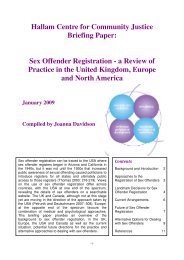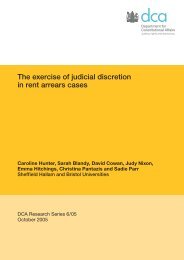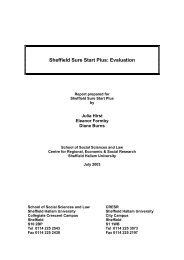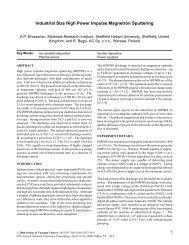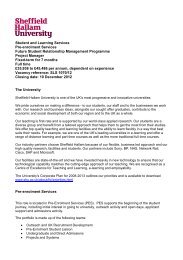Carbon Offset Demystified
Carbon Offset Demystified
Carbon Offset Demystified
Create successful ePaper yourself
Turn your PDF publications into a flip-book with our unique Google optimized e-Paper software.
<strong>Carbon</strong> Trading<br />
Mark Chadwick, CEO<br />
<strong>Carbon</strong> Clear Limited
Agenda<br />
• Introduction to <strong>Carbon</strong> Clear<br />
• Background to carbon trading<br />
– What is carbon trading?<br />
– Why trade carbon credits?<br />
– How are they made?<br />
• <strong>Carbon</strong> trading in your organisation<br />
• Clinic: Q&A about trading in your organisation
Introduction to <strong>Carbon</strong> Clear<br />
• Mark Chadwick<br />
– CEO, <strong>Carbon</strong> Clear Limited<br />
• <strong>Carbon</strong> Clear Limited<br />
1. Corporate climate change strategy<br />
2. <strong>Carbon</strong> footprint measurement<br />
3. Internal emission reductions<br />
4. <strong>Carbon</strong> trading<br />
5. Legislative compliance
Background to carbon trading<br />
… what, why and how
What is carbon trading?<br />
• <strong>Carbon</strong> trading is the buying and selling of carbon credits<br />
• Definition: <strong>Carbon</strong> Credit<br />
– An instrument representing a reduction in greenhouse<br />
gas emissions, usually denominated in metric tonnes<br />
• Primarily found in the compliance markets such as the<br />
European Emissions Trading Scheme or <strong>Carbon</strong> Reduction<br />
Commitment<br />
• Increasingly used by other businesses to achieve reduction<br />
goals or demonstrate their green credentials
Why trade carbon credits?
Why trade carbon credits?<br />
60<br />
50<br />
40<br />
30<br />
20<br />
10<br />
0<br />
-10<br />
-20<br />
-30<br />
Performance of highlighted countries<br />
Spain Italy UK Norway<br />
Under performance<br />
Over performance<br />
Achieved<br />
Promised
Why are they needed?<br />
• <strong>Offset</strong>s allow countries or companies who are targeted to<br />
reduce their emissions to trade between each other<br />
• GOAL: Achieve compliance at lowest cost by using<br />
market forces to allocate capital<br />
• Why I like it<br />
– Use market forces to price an externality; in this case<br />
greenhouse gas pollution
How are they made?<br />
• Permits to pollute<br />
– Issued by a regulating<br />
body to place a cap on<br />
emissions<br />
– Emission reduction<br />
performance impacts<br />
supply<br />
– Allocations usually<br />
reduced year on year<br />
– Permits have limited<br />
use outside of the<br />
compliance sphere<br />
– E.g. EUA<br />
• Emission reduction projects<br />
– Derived from projects that lie<br />
outside of the compliance<br />
sphere<br />
– Based on emission reductions<br />
from projects, e.g. wind farms<br />
or industrial efficiency<br />
improvements<br />
– Issued based on the reduced<br />
emissions after a project versus<br />
emissions prior to the project<br />
– E.g. CER, ERU, VER
How are they made?<br />
60<br />
50<br />
40<br />
30<br />
20<br />
10<br />
0<br />
With project emissions versus baseline<br />
2007 2008 2009 2010 2011 2012<br />
Baseline With Project<br />
<strong>Carbon</strong> Credits
<strong>Carbon</strong> trading in your organisation<br />
… where and how will you encounter carbon trading
Climate Change Act<br />
• Climate Change Bill introduced in November 2007 and<br />
signed into law on 26 th November 2008… thus becoming the<br />
Climate Change Act<br />
• DEFRA: “…world’s first long term legally binding framework<br />
to tackle the dangers of climate change”<br />
• Key points; long term & legally binding<br />
• Government set 5 year legally binding “carbon budgets”<br />
• Budgets for 2008-2012, 2013-2017 and 2018-2022 have<br />
been set requiring a reduction in emissions of 31% from<br />
2005 levels<br />
• Equal to a reduction in emissions of 175 MtCO 2e<br />
• Commitment to reduce emission 80% from 1990 levels to be<br />
achieved by 2050 (41 years time)
Existing UK climate policy levers<br />
<strong>Carbon</strong><br />
Reduction<br />
Commitment<br />
<strong>Carbon</strong><br />
Neutral<br />
Commitment<br />
DEC<br />
CCL<br />
Legislation<br />
EPC<br />
CCA<br />
ETS<br />
Building<br />
Regulations
<strong>Carbon</strong> trading in your organisation<br />
• EU Emissions Trading Scheme<br />
– Large emitters<br />
– Single source such as power stations, incinerators, CHP<br />
installations<br />
• <strong>Carbon</strong> Reduction Commitment<br />
– Large non-energy intensive businesses<br />
– Trading CRC permits representing 1 tonne of CO2<br />
• Voluntary Schemes<br />
– <strong>Carbon</strong> neutral organisations
Cinic: Questions and comments about carbon<br />
trading in your organisation
Concluding thoughts
Lifecycle of a carbon credit<br />
… a real life example
<strong>Carbon</strong> credit projects<br />
•At <strong>Carbon</strong> Clear we invest in projects that improve living<br />
standards in developing countries, while providing global<br />
climate benefits.<br />
•Verifiable emissions reductions<br />
• ISO 14064-2 reporting<br />
• Third-party verification<br />
•Additionality<br />
• CDM measurement rules<br />
•Sustainable livelihoods<br />
• DfID evaluation criteria<br />
•Materiality<br />
• Client’s contribution makes a real<br />
difference<br />
•Diverse portfolio<br />
• Minimum 80% clean energy
Saving more than the environment:<br />
Mini-Taxi Engine Retrofits in the Philippines<br />
•Size: 100K tCO2e<br />
•Providing support to a local business that converts<br />
two-stroke mini-taxi engines to modern fuel-injection<br />
technology. More efficient engines reduce carbon<br />
emissions and ambient air pollution.<br />
•Monitoring: Project created and managed by our local partner Envirofit. Project<br />
will be submitted to the CDM Executive Board with independent verification by a<br />
UN Designated Operational Entity.<br />
•Why we like it:<br />
– High climate change reduction potential<br />
– New business opportunities for local entrepreneurs<br />
– Improving air quality in cities<br />
– Reduced fuel costs for taxi drivers
<strong>Carbon</strong> Credit Development<br />
How are they made?<br />
Sale<br />
Verification<br />
Monitoring<br />
Validation<br />
Start<br />
Contract<br />
Concept<br />
Compliance Market<br />
•Trades CERs / EUAs<br />
•European trading scheme<br />
•700m tonnes per annum<br />
•€23 per tonne<br />
Voluntary Market<br />
•Trades CERs / VERs<br />
•23m tonnes<br />
worldwide in 2006<br />
• €8-10 per tonne
Monitoring<br />
• Each retrofit includes an engine management computer<br />
which monitors fuel flow<br />
• Lower levels of fuel consumption mean lower carbon<br />
emissions<br />
• Quarterly reports are submitted to <strong>Carbon</strong> Clear<br />
• Annual 3 rd party verification of emissions reductions<br />
provides actual carbon credit numbers




